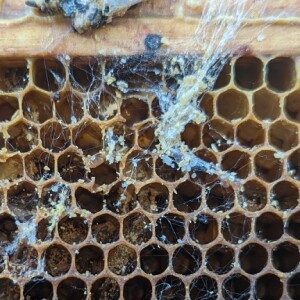And another thing
I was determined not to seek out bugs in the garden today, but this common darter sought me out while I was doing other things - yet another poser, prepared to sit there while I did my best to get a picture mostly in focus. It truth, it has replaced the nightmare image in the extra so has, I think, done us all a favour
The extra is biologically interesting, but ugly, unpleasant and evidence of some pretty shoddy beekeeping. This is wax moth damage. The adult moth lays dozens of the small black eggs that you can see on the wooden frame at the top of the picture. The eggs hatch to produce larvae that burrow through the wax, feasting on both it and on the protein in the brown-coloured propolis that lines the cells in the comb. You can just see a burrow in the bottom of four or five cells, running diagonally across the centre of the frame from 1 o'clock to 7 o'clock. As they are burrowing, the larvae release sticky, silky thread, like tacky spider's web, that you see everywhere in the picture
When it has had its fill, the larva pupates in a tough, firmly-attached cocoon, woven from the same sticky strands. They are really hard to remove, but I pulled off the one at the top, beside the eggs. After metamorphosis within the cocoon, the adult moth emerges and the whole cycle begins again. The comb is soon destroyed and bound up in a sticky mess, embedded with persistent, discarded cocoons
This has all happened because I have neglected to monitor combs I had in storage and the moths have become established. In mitigation, we have been dealing with virus infection of colonies, mysteriously lost queens, wasp attacks and Covid - it does feel a little bit like the ten plagues of Egypt - but moths aren't interested in excuses! I have treated all the frames with a biological control agent - the spores of a moth-specific bacterial parasite called Bacillus thuringiensis. This will kill any new larvae that hatch, and I think most of the combs (but not this one!) will be salvageable
Wax moth have one virtue to set against their many sins. It has recently been discovered that the larvae can not only digest wax, but also certain kinds of plastic, so may help with the breakdown of the plastic mountain that is engulphing the planet. I hope they rapidly develop a taste for it


Comments
Sign in or get an account to comment.


